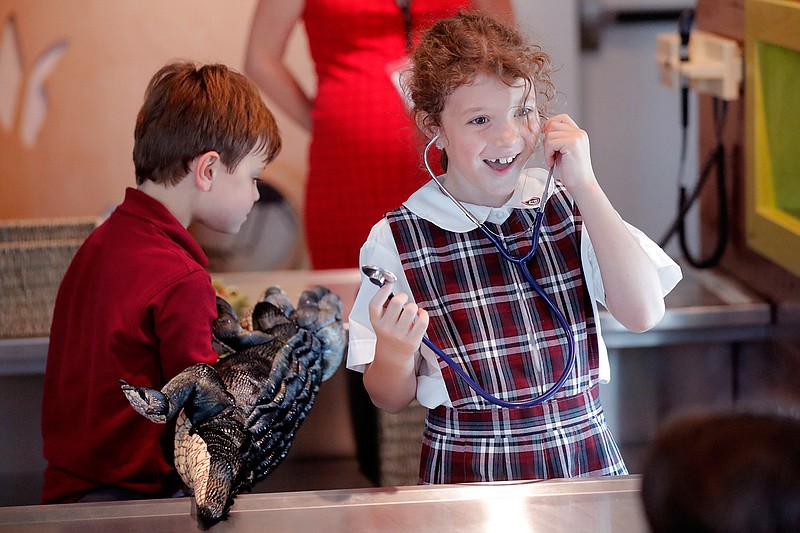NEW ORLEANS - Louisiana's oldest children's museum has a shiny new home with spaces for kids of all ages, from those just learning to crawl to those who want a close-up view of a cicada's delicate wings.
The Louisiana Children's Museum's new $47.5 million environmentally conscious building is opening in City Park. The campus includes lots of outside space to run around in, a toddler play area with a small picnic table, and a small lagoon with a floating classroom.
Indoors, a "sensory lagoon" includes a ramp with pillows over which small children can crawl up to a veterinary waterbed decorated to look like a lily pond and nearly surrounded by mirrors.
"They love the sound," CEO Julia Bland said, kneeling down and pushing the top to make the water slosh.
It's in the "Play with Me" area designed for babies, toddlers, and their grown-ups.
As scientists have learned more about very early learning, children's museums have come to see babies as "valuable and valued museum visitors," said Laura Huerta Migus, executive director of the Association of Children's Museums. "How do we create enriching environments specifically designed to enhance children's overall development? ... It's about giving access to those objects that even babies can touch and begin to understand the world around them."
"Young people between the ages of six and twenty years" were the target audience when the first children's museum, the Children's Museum of Brooklyn, opened in 1899, according to an article in a 1900 edition of "Scientific American."
The page-long article mentioned "a splendid series of twenty-four anatomical models" including a 5-foot-long silkworm and a 3-foot-long snail that lecturers could "dissect" to illustrate internal workings.
Children's museums, like the one in New Orleans, now are far more hands-on, even hands-in.
"Splashing is a child's joyful exploration of water," reads a sign in a small kid-waist-high pool. "When children splash in a puddle or tub, they are testing how water behaves and how their actions affect it."
The pools stand in front of a photographic mural showing the Mississippi River's headwaters in Minnesota - one of the few pieces of wall art that wasn't reproduced from a child's drawing. On the fountains' other side is the start of a 100-foot-
long winding metal Mississippi River filled with flowing water.
"This is our biggest exhibit, our most expensive exhibit and probably the most important in terms of global and local issues," Bland said.
Hand-driven pumps represent the various rivers that flow into the Mississippi. Just before "New Orleans" a metal gate can be opened to show how a spillway - like the one opened for more than 120 days this year because the Mississippi was so high - can divert part of the river's flow.
Another section is about nature, with stuffed toys for smaller kids to play veterinarian.
For older ones, there's a videomicroscope hooked to an HDTV screen and a host of insects, minerals, bones, plant specimens and other samples to look at.
One of the largest galleries is all about food, including a grocery store, kitchen and café.
"Nobody's ordering cappuccino! And it's so good!" Sophia Lirette, 6, said as some of her schoolmates at Christian Brothers School - which also has a campus in the 1,300-acre City Park - carried tray after tray heaped high with plastic tacos, muffins, chicken, crawfish and more. The kids were taking part in a preview of the museum Tuesday.
There's also a kid-sized take on the brightly painted truck driven by Arthur James Robinson, better known as "Mr. Okra." Robinson used to drive around New Orleans selling fruits and vegetables in the city's neighborhoods from the back of his truck, calling out to residents about what he had available.
At the front of the truck is a map of city neighborhoods that can change to pictures of produce. Bland said they recorded Robinson's calls before he died in February 2018. Touch a picture of green beans, and Robinson's voice sings out, "I got green beans!"
The museum's outdoor area includes a "pelican's nest" where kids can weave a rope nest, a set of shiny steel drums, an edible garden, and two floating islands of native plants on anchored beds of recycled plastic. The islands are for birds, not children; swans and ducks are among the birds that have used them, said museum spokeswoman Leslie Doles.
One outdoor sign notes: "Playing in nature is good for kids. ... Dirt, scratches, and bumps are part of natural play."

